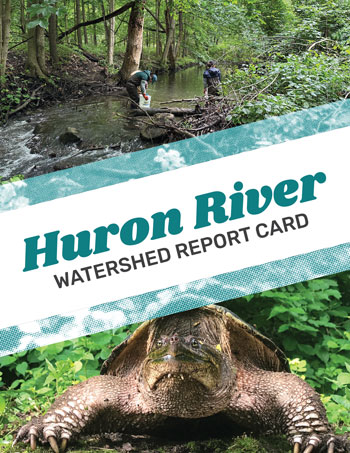Our April edition of News to Us highlights noteworthy headlines from across Michigan and the U.S. Articles cover the new federal PFAS drinking water standards and the release of the first-ever report cards for Southeast Michigan watersheds, including the Huron. There are articles on the growing challenges with groundwater salinity and invasive plants in Michigan as well as updates on the Clean Water Act and Huron River fish stocking.
EPA sets new clean drinking water standards for PFAS aimed at removing ‘forever chemicals’
In early April, the U.S. Environmental Protection Agency finalized new drinking water standards targeting per- and polyfluoroalkyl (PFAS) compounds. The new federal PFAS rules set maximum contaminant levels (MCLs) for six PFAS compounds that are stricter than Michigan’s current MCLs for seven PFAS compounds. The standards require the nation’s over 2,700 public drinking water suppliers to actively monitor and mitigate PFAS levels. Suppliers have until 2029 to adopt new treatment technologies and bring their systems into compliance. For more information, read a blog from HRWC Watershed Planner Dan Brown on the new PFAS standards.

Opinion: Investment a pressing need for urbanized water resources
New report cards from the University of Maryland’s Center for Environmental Science give Southeast Michigan’s watersheds a collective “C” grade. The five Southeast Michigan watersheds—Clinton, Detroit, Huron, Rouge and Raisin—were assessed using social, economic, and environmental data. The Huron River earned a C+, with high indicator scores in water quality and recreation. Read more about the Huron River report card in a blog from HRWC Executive Director Rebecca Esselman.
As feds stand down, states choose between wetlands protections or rollbacks
A U.S. Supreme Court ruling stripped federal protection from millions of acres of wetlands, leaving states to decide their fate. Some have created state-level protections and others are rolling back regulations. The divide has led to concerns about the impact on water quality and wildlife habitat. For example, Illinois and Indiana are moving in opposite directions, with Illinois working to establish wetlands protections while Indiana rolls back regulations. Additionally, Colorado, New Mexico, and Washington are considering steps to create wetlands protections or increase funding for state regulatory agencies.
Salty groundwater in Michigan could hurt agriculture, business and homeowners
Michigan is grappling with a rising salinity problem in its groundwater, posing risks to infrastructure and agriculture. The increasing salinity is largely due to the underground geology of the state and the deep, salty aquifers thousands of feet below ground that are accidentally tapped by wells. The issue has not reached the radar of most Michigan residents and lawmakers. However, researchers are beginning to study and map wells and aquifers across the state to improve understanding.
Meet the invasive plant that’s killing off Michigan’s spring wildflowers
Lesser celandine, an invasive plant, is rapidly spreading across Michigan’s lower peninsula and threatening native plant species. Despite being introduced in the U.S. as an ornamental plant from Europe in the 1800s, lesser celandine has only just began to proliferate in Michigan’s forests. To mitigate its further spread to northern Michigan, nature resource managers and advocates are conducting herbicide treatments, monitoring its presence across the state, and advocating for regulations to ban its sale.
Adult trout stocked in southeast Michigan
The Michigan Department of Natural Resources recently stocked the Huron River with nearly 2,800 adult trout at Proud Lake and Island Lake Recreation Areas. According to this article from Outdoor News, around 1,370 brown trout and 1,400 rainbow trout were released into the Huron River just downstream of Proud Lake Dam. All the stocked trout range from 13 to 19 inches in length. Beginning April 30th, anglers may keep up to five trout over 8 inches, but only three over 15 inches. Until then, additional fishing regulations apply.



